Gillespie, J. H. (McKechnie Section 2)
See also Section Six
Gillespie appears to have been an itinerant artist, since he gives no address on his trade label. Jackson (Dictionary) tells us that he worked in London, Edinburgh and Liverpool, leaving England in 1820 for Halifax, Nova Scotia. Jackson gives the date 1793 for Gillespie's work, and he may have been working as early as this, but examples of his work seen by me appear to date from 1810-20. Gillespie's style suggests that of a miniature painter on ivory; that is, he worked with fine practised strokes, and was adept in the use of gum arabic. He is indeed listed by Foskett, who mentions profile miniatures in colour and silhouettes.
I own a handbill used by Gillespie in Bridgnorth, which is unfortunately not dated but came from a bundle of printers' proofs originating from this town; from its place in this collection, which appears to have been kept in chronological order, it was probably printed c. 1818-20. It is printed on laid paper. It tells us that Gillespie used a 'Physiognograph' (probably yet another version of the physiognotrace), and also that he planned to stay for a few weeks in Bridgnorth, where his address was at 'Mr Brickley's, High Street'. He was very likely on his way north to Liverpool for his journey to Nova Scotia, and probably stayed for a few weeks in several towns on the journey. The handbill also tells us that Gillespie was a drawing master and a seller of frames for miniatures.
Foskett states that Gillespie was in Halifax, Nova Scotia, in 1829, in Baltimore in 1837, in Philadelphia in 1838 and that he visited New York. Gillespie, therefore, on the available evidence, appears w have worked in England 1810 - c. 1820, and then in North America as late as 1838.
Although Gillespie painted in a style not uncommon in his day (in shades of dark grey, with line drawing added in black pigment to show details of clothing), his brushwork is especially neat, and appears from the illustrated examples to follow a consistent pattern. Especially distinctive is the group of fanning strokes of gum arabic with which he separated the arm from the rest of the profile. His portraits of men have a deep line of gum arabic at the M notch between lapel and collar which was much in fashion at the time, and the line beneath the collar is almost as deep. Tail-coats worn by men during the years just before 1820 had high collars, which turned down only part of the way at the back; on his profiles of men, Gillespie shows the corrugations at the back of the neck which were part of this fashion. Hair is not over-painted in gum arabic; it is shown as a dark grey mass. with swirling brush-strokes in the same colour indicating the shape of the hair-style. Shirt-frills and cravats are left blank, and the detail is carefully painted in with a brush.
The detail of women's clothing is painted in fine fines of gum arabic over the same dark grey base: a laborious technique, since Gillespie worked at a time when ruffs at the neck were much in fashion for women.
Gillespie was one of the profilists who took the trouble to indicate the eyebrow, which he painted in a small swirl of fine strokes of the same pigment which he used on the body of the profile.
One black-against-grey bust-length profile has been seen. This differed slightly from the illustrated example painted in this style in that the sitter's waist-coat, protruding well beyond the line of the profile in front, was painted in thinned pigment, which gave the work a finished and very professional appearance.
Jackson tells us that Gillespie sometimes painted in colour or in base colours of black or dark brown, slightly bronzed. A bronzed painted example (illustrated) has recently come to light. The sitter is a woman, and the silhouette was painted perhaps in c. 1818. The work is not as finished as on the black-against-grey examples. Although Gillespie has taken care with the gold brushwork which indicates the hair, necklace, and (though this is less expertly painted) the dress, he appears to have tried mixing some gold paint with the black base on the rest of the work, with the result that a greenish hue has been introduced into the background, giving an untidy effect.
814
The Bridgnorth handbill mentions 'Bronzed Busts, or shaded in watercolours, at 5s. and 7s. 6d. each', as well as 'Children, in colours and full-length, 5s. and 7s. 6d. each'. It will be noted that 'watercolours' is in the plural; these were probably profile miniatures in colour (mentioned by Foskett). The two prices quoted for portraits of children may suggest that these were painted in black (or bronzed) for 5s, and painted in colour for 7s. 6d. The artist does not specify that he is prepared to paint portraits of adults in full-length. He also offers 'Likenesses, with the features neatly shaded on Black grounds, in imitation of Copper-Plate busts, at 5s. each'.
Two trade labels (illustrated) are known. They carry the same wording, but are set in different type-faces. Neither bears an address. No. 1 has been seen on a silhouette taken 1813-15. No. 2 has been seen on one of a set of eight likenesses' of members of the Hartley family (see Section Six). These were all inscribed with the date 1816, and were evidently taken in Manchester, for one of the inscriptions ('Drawn by J. H. Gillespie, Profile-Painter') was written on the back of a fragment of an issue of the Manchester Chronicle.
Ills. 811-817
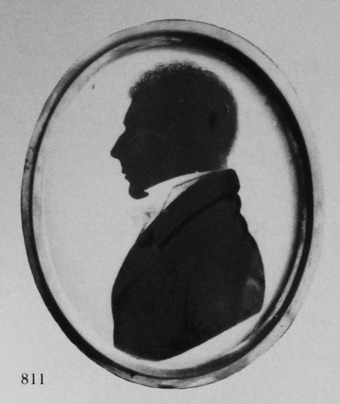
Unknown man
Silhouette painted on card, with black pigment and added gum arabic against a dark grey background
? c. 1813-15
3 x 2¼in./77 x 58mm.
Trade Label No. 1
Frame: papier mâché, with hanger showing a maquis’ crown
The buttonhole in the lapel turn of the sitter’s coat is typical of the date.
Author’s collection
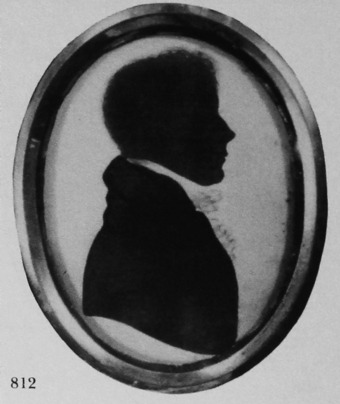
Thomas Town
Silhouette painted on card, with black pigment and added gum arabic against a dark grey background
? c. 1813-15
3 x 2¼in./77 x 58mm.
The buttonhole in the lapel turn of the sitter’s coat is similar to that shown in 811, and is likewise typical of the date.
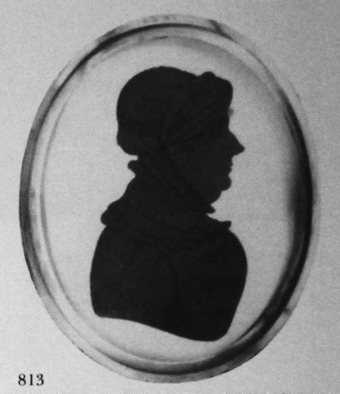
Unknown woman
Silhouette painted on card, with black pigment and added gum arabic against a dark grey background
? c. 1813-15
3 x 2¼in./77 x 58mm.
Trade Label No. 1
Frame: papier mâché, with hanger showing a maquis’ crown
The buttonhole in the lapel turn of the sitter’s coat is typical of the date.
Author’s collection

Unknown woman
Silhouette painted on card, bronzed against black
c. 1818
3 x 2¼in./77 x 58mm.
Trade Label No. 1
Frame: papier mâché
Elliott Levy collection
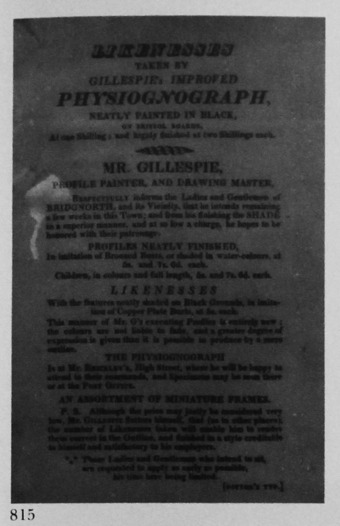
Handbill of J. H. Gillespie, made as a folder, with the second sheet blank. Used in Bridgnorth, c. 1818-20.
Size of double sheet: 3 7/8 x 4 3/8 in./99 x 112mm.
Author’s collection
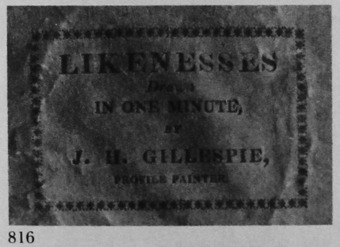
Trade Label No. 1 of J. H. Gillespie, from the silhouette shown in 811.
Author’s collection

Trade Label No. 2 of J. H. Gillespie, from the profile shown in 1532.
By courtesy of R. H. Howorth
